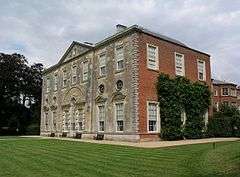Ralph Verney, 2nd Earl Verney
Ralph Verney, 2nd Earl Verney PC, FRS (1 February 1714 – 31 March 1791), styled Viscount Fermanagh between 1743 and 1752, was a British politician who sat in the House of Commons between 1753 and 1791.

Background
A member of the Verney family, Lord Verney was the son of Ralph Verney, 1st Earl Verney, of Claydon House, Buckinghamshire, and Catherine, daughter of Henry Paschall.[1]
Political career
Verney succeeded his father in the earldom in 1752. However, as this was an Irish peerage, it did not entitle him to a seat in the House of Lords (although it did entitle him to a seat in the Irish House of Lords). In 1754 Lord Verney was one of the largest landowners in Buckinghamshire; controlled two seats at Wendover; owned burgages at Great Bedwyn. He went on to acquire a considerable interest at Carmarthen. Through folly and extravagance he wasted his fortune and finally had to sell or surrender his parliamentary interest.
Under George II and in the early years of George III he was a regular Government supporter, and in 1754 and 1761 placed one seat at Wendover at Newcastle's disposal. But in 1761 Lord Fitzmaurice wrote that Verney was ‘much offended with the Duke of Newcastle’, [2] and Verney himself in 1763 stated that he had never received ‘the smallest obligation’ from the Pelhams.2 In 1761 or 1762 he became acquainted with William Burke, about whom Fox wrote in 1763:3 ‘He has as great a sway with Lord Verney as I ever knew one man have with another.’ In November 1762, when Fox was engaged in securing a majority for the peace preliminaries, Verney was ‘the very man he knew not how to come round’; and was won over by William Burke.4 On 9 Dec. Verney seconded the Address on the peace preliminaries, and, according to Fox, was ‘never absent’ that session.
On 9 Apr. 1763 he applied to Fox for a British peerage:5 ‘My fortune is above £10,000 per annum’, he wrote, ‘... my own personal attachment to Government has been sincere, constant, and uniform ... and ... I have expended very large sums in several elections without obtaining, or indeed asking to this time, any favour whatever.’ And to Grenville, 29 Apr. 1763:6 ‘My whole life has shown how much I have been inclined to forward the business of the Crown.’
He was hurt and disappointed that nothing had been done for him, and Grenville could make no promises. Nor did he help towards vacating the seat at Wendover which Verney wanted for William Burke. On 12 Nov. 1763 Holland wrote to Sandwich:7 ‘Lord Temple has courted Lord Verney extremely, and he thinks Mr. Grenville has neglected him.’ Certainly Grenville and Verney seem to have had no liking for each other; yet Verney, although he spoke for the repeal of the cider duty, 31 Jan. 1764, did not vote against Grenville's Administration in any of the divisions over general warrants nor was he ever claimed by the Opposition as one of their adherents.
William Burke was given a place by the Rockingham Administration, and Verney was made a P.C.—an unusual distinction for one who held no office. He followed the Burkes into opposition and voted consistently with the Rockinghams, but was never in the party's inner circle: he did not, for example, attend the Opposition dinner of 9 May 1769, and in 1774 so prominent a figure as Richmond did not know him.8 After 1764 only one speech by him is recorded—5 June 1780, on presenting the Buckinghamshire petition.
Claydon House
He rebuilt Claydon House in Buckinghamshire between 1757 and 1771. The house today represents only the west wing, which was originally connected to an identical east wing by a colonnaded rotunda surmounted by a cupola. Cost overruns on the building meant that Lord Verney had to spend the final years of his life on the continent to escape his creditors.
Family
Lord Verney married Mary, daughter of Henry Herring, in 1740. This marriage introduced a settlement of £30,000 to the family as Herring was one of the Directors of the Bank of England. Lord Verney also received £40,000 from the settlement received by his late brother's widow, Mary Nicholson. His elder brother, The Hon. John Verney had died in 1737 only a year after his marriage. This marriage produced only one daughter, Mary Verney, and so the estate instead passed to Ralph, who became the 2nd Earl Verney. He and the Countess had no children before her death in January 1791, aged 74. Lord Verney only survived her by two months and died in March of the same year, aged 77. On his death all his titles became extinct.[1] His estate was inherited by his niece Mary Verney (later created Baroness Fermanagh, in the second creation), who reduced Clayton House to its present size.
References
- Lundy, Darryl. "p. 2981 § 29805". thepeerage.com. Retrieved 12 January 2012.
| Parliament of Great Britain | ||
|---|---|---|
| Preceded by John Hampden The Earl Verney |
Member of Parliament for Wendover 1753–1761 With: John Hampden 1753–1754 John Calvert 1754–1761 |
Succeeded by Richard Chandler-Cavendish Verney Lovett |
| Preceded by Griffith Philipps |
Member of Parliament for Carmarthen 1761–1768 |
Succeeded by Griffith Philipps |
| Preceded by Richard Lowndes Sir William Stanhope |
Member of Parliament for Buckinghamshire 1768–1784 With: Richard Lowndes 1768–1774 George Grenville 1774–1779 Thomas Grenville 1779–1784 |
Succeeded by William Grenville Sir John Aubrey, Bt |
| Preceded by William Grenville Sir John Aubrey, Bt |
Member of Parliament for Buckinghamshire 1790–1791 With: William Grenville 1790 James Grenville 1790–1791 |
Succeeded by James Grenville The Marquess of Titchfield |
| Peerage of Ireland | ||
| Preceded by Ralph Verney |
Earl Verney 1752–1791 |
Succeeded by Extinct |